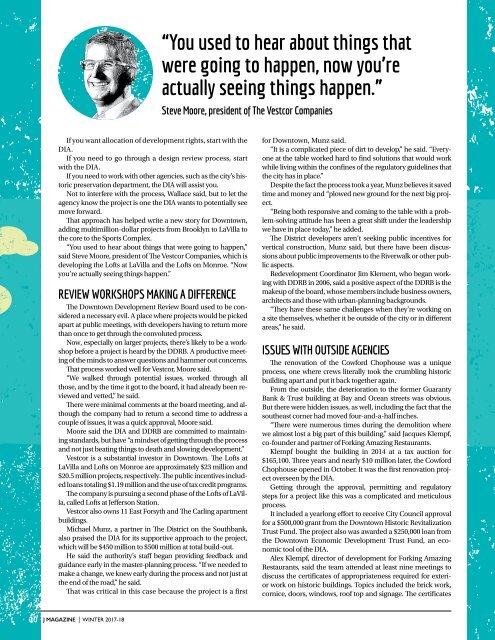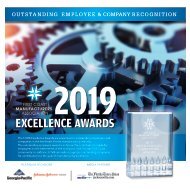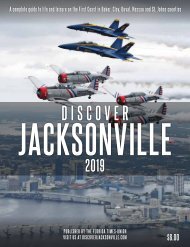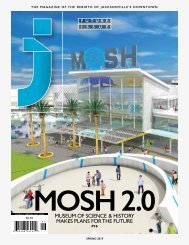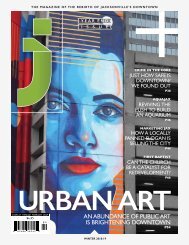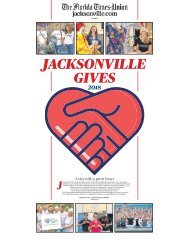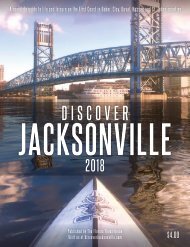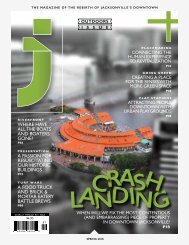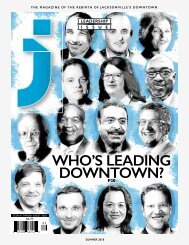J Magazine Winter 2017
The magazine of the rebirth of Jacksonville's downtown
The magazine of the rebirth of Jacksonville's downtown
Create successful ePaper yourself
Turn your PDF publications into a flip-book with our unique Google optimized e-Paper software.
“You used to hear about things that<br />
were going to happen, now you’re<br />
actually seeing things happen.”<br />
Steve Moore, president of The Vestcor Companies<br />
If you want allocation of development rights, start with the<br />
DIA.<br />
If you need to go through a design review process, start<br />
with the DIA.<br />
If you need to work with other agencies, such as the city’s historic<br />
preservation department, the DIA will assist you.<br />
Not to interfere with the process, Wallace said, but to let the<br />
agency know the project is one the DIA wants to potentially see<br />
move forward.<br />
That approach has helped write a new story for Downtown,<br />
adding multimillion-dollar projects from Brooklyn to LaVilla to<br />
the core to the Sports Complex.<br />
“You used to hear about things that were going to happen,”<br />
said Steve Moore, president of The Vestcor Companies, which is<br />
developing the Lofts at LaVilla and the Lofts on Monroe. “Now<br />
you’re actually seeing things happen.”<br />
Review workshops making a difference<br />
The Downtown Development Review Board used to be considered<br />
a necessary evil. A place where projects would be picked<br />
apart at public meetings, with developers having to return more<br />
than once to get through the convoluted process.<br />
Now, especially on larger projects, there’s likely to be a workshop<br />
before a project is heard by the DDRB. A productive meeting<br />
of the minds to answer questions and hammer out concerns.<br />
That process worked well for Vestcor, Moore said.<br />
“We walked through potential issues, worked through all<br />
those, and by the time it got to the board, it had already been reviewed<br />
and vetted,” he said.<br />
There were minimal comments at the board meeting, and although<br />
the company had to return a second time to address a<br />
couple of issues, it was a quick approval, Moore said.<br />
Moore said the DIA and DDRB are committed to maintaining<br />
standards, but have “a mindset of getting through the process<br />
and not just beating things to death and slowing development.”<br />
Vestcor is a substantial investor in Downtown. The Lofts at<br />
LaVilla and Lofts on Monroe are approximately $23 million and<br />
$20.5 million projects, respectively. The public incentives included<br />
loans totaling $1.19 million and the use of tax credit programs.<br />
The company is pursuing a second phase of the Lofts of LaVilla,<br />
called Lofts at Jefferson Station.<br />
Vestcor also owns 11 East Forsyth and The Carling apartment<br />
buildings.<br />
Michael Munz, a partner in The District on the Southbank,<br />
also praised the DIA for its supportive approach to the project,<br />
which will be $450 million to $500 million at total build-out.<br />
He said the authority’s staff began providing feedback and<br />
guidance early in the master-planning process. “If we needed to<br />
make a change, we knew early during the process and not just at<br />
the end of the road,” he said.<br />
That was critical in this case because the project is a first<br />
for Downtown, Munz said.<br />
“It is a complicated piece of dirt to develop,” he said. “Everyone<br />
at the table worked hard to find solutions that would work<br />
while living within the confines of the regulatory guidelines that<br />
the city has in place.”<br />
Despite the fact the process took a year, Munz believes it saved<br />
time and money and “plowed new ground for the next big project.<br />
“Being both responsive and coming to the table with a problem-solving<br />
attitude has been a great shift under the leadership<br />
we have in place today,” he added.<br />
The District developers aren’t seeking public incentives for<br />
vertical construction, Munz said, but there have been discussions<br />
about public improvements to the Riverwalk or other public<br />
aspects.<br />
Redevelopment Coordinator Jim Klement, who began working<br />
with DDRB in 2006, said a positive aspect of the DDRB is the<br />
makeup of the board, whose members include business owners,<br />
architects and those with urban-planning backgrounds.<br />
“They have these same challenges when they’re working on<br />
a site themselves, whether it be outside of the city or in different<br />
areas,” he said.<br />
issues with outside agencies<br />
The renovation of the Cowford Chophouse was a unique<br />
process, one where crews literally took the crumbling historic<br />
building apart and put it back together again.<br />
From the outside, the deterioration to the former Guaranty<br />
Bank & Trust building at Bay and Ocean streets was obvious.<br />
But there were hidden issues, as well, including the fact that the<br />
southeast corner had moved four-and-a-half inches.<br />
“There were numerous times during the demolition where<br />
we almost lost a big part of this building,” said Jacques Klempf,<br />
co-founder and partner of Forking Amazing Restaurants.<br />
Klempf bought the building in 2014 at a tax auction for<br />
$165,100. Three years and nearly $10 million later, the Cowford<br />
Chophouse opened in October. It was the first renovation project<br />
overseen by the DIA.<br />
Getting through the approval, permitting and regulatory<br />
steps for a project like this was a complicated and meticulous<br />
process.<br />
It included a yearlong effort to receive City Council approval<br />
for a $500,000 grant from the Downtown Historic Revitalization<br />
Trust Fund. The project also was awarded a $250,000 loan from<br />
the Downtown Economic Development Trust Fund, an economic<br />
tool of the DIA.<br />
Alex Klempf, director of development for Forking Amazing<br />
Restaurants, said the team attended at least nine meetings to<br />
discuss the certificates of appropriateness required for exterior<br />
work on historic buildings. Topics included the brick work,<br />
cornice, doors, windows, roof top and signage. The certificates<br />
20 J MAGAZINE | WINTER <strong>2017</strong>-18


